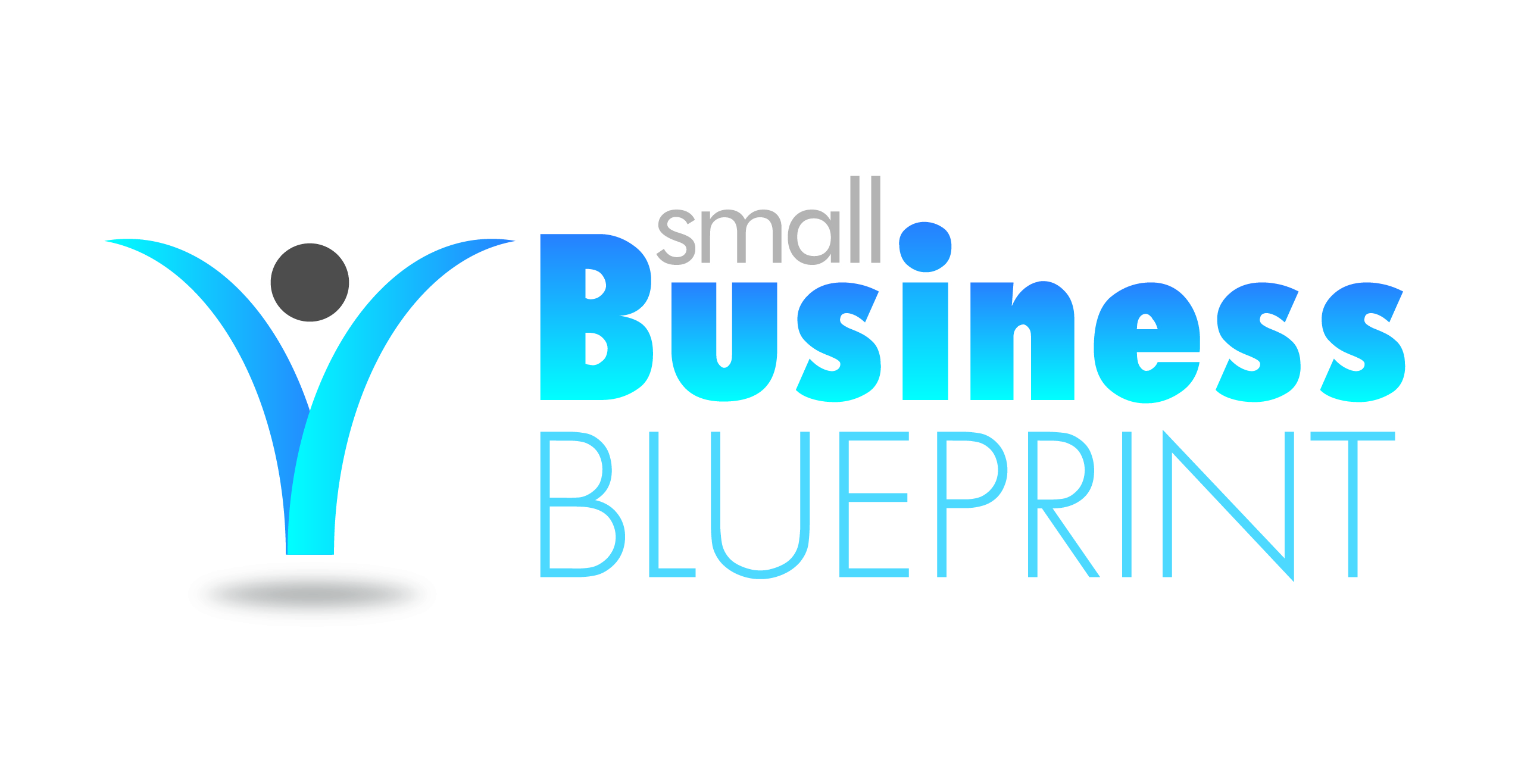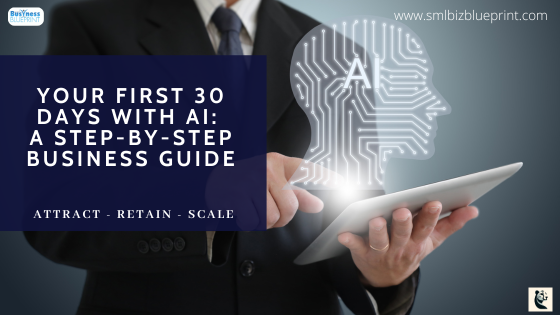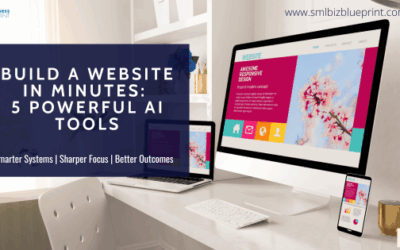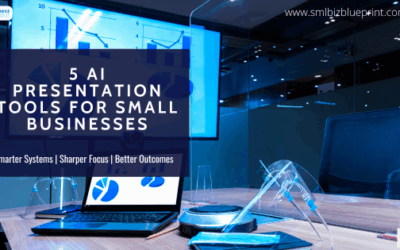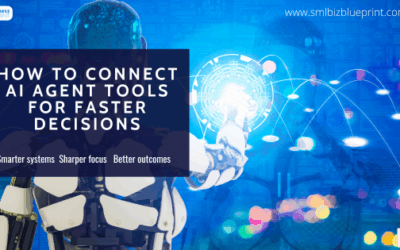AI is no longer just a futuristic buzzword—it’s a real, practical tool that’s transforming how businesses operate today.
Yet, for many business owners, AI implementation feels overwhelming.
The questions pile up: Where do I start? What AI tools should I use? Will it be expensive? Will my team embrace it?
You’re not alone. 85% of small business owners believe AI will give them a competitive edge, yet most feel uncertain about integrating it into their operations (Forbes, 2024).
The truth is AI doesn’t have to be complex or intimidating. When approached with a structured roadmap, AI can save time, cut costs, and boost revenue—within just the first 30 days.
This guide is your step-by-step AI adoption plan.
We’ll walk you through:
✅ The essential AI tools that will deliver immediate business impact
✅ How to automate daily tasks and free up your time
✅ How AI can improve marketing, sales, and customer service
✅ Common AI pitfalls (and how to avoid them)
✅ What to do after 30 days to scale AI effectively
By the end of this post, you’ll have a clear, actionable plan to start using AI in your business—without confusion, tech jargon, or unnecessary expenses.
🔹 Ready to leverage AI to work smarter, not harder?
Let’s dive in.

#1 Why AI is Essential for Business Owners
AI is no longer a luxury—it’s a necessity for businesses looking to stay competitive. From automating repetitive tasks to analysing vast amounts of data in seconds, AI is helping business owners save time, cut costs, and drive revenue growth.
Yet, many small business owners hesitate to embrace AI, believing it’s too complex, expensive, or only for large enterprises.
The reality?
AI tools today are affordable, easy to integrate, and designed specifically for small businesses.
How AI is Already Transforming Businesses
AI adoption is accelerating across industries, and businesses that leverage AI early gain a competitive edge.
Here’s how AI is making an impact:
✅ Automating Repetitive Tasks: AI-powered tools handle tasks like email responses, scheduling, and invoicing, freeing up time for high-value work.
✅ Enhancing Decision-Making: AI analyses large data sets in real-time, providing business owners with insights that drive smarter decisions—whether it’s predicting customer trends, optimising pricing, or managing inventory.
✅ Improving Customer Experience: AI-powered chatbots provide instant customer support, personalising interactions and reducing response times.
✅ Boosting Marketing & Sales: AI automates email marketing, social media content, and ad targeting, ensuring businesses reach the right audience at the right time.
🏆 AI is No Longer Optional—It’s a Business Advantage
The AI revolution is already here, and businesses that fail to adapt risk being left behind.
AI is More Affordable Than You Think:
You don’t need a big budget to get started.
Many AI-powered tools offer free trials or low-cost entry plans, making it easy for small businesses to test AI before making a financial commitment.
Tips:
✔️ Identify One Repetitive Task to Automate
Start by listing daily tasks that take too much time (e.g., answering FAQs, sending emails, scheduling meetings). Research AI tools like Zapier or ChatGPT to handle these tasks automatically.
✔️ Use AI for Smarter Decision-Making
Leverage AI-powered analytics tools like Google Analytics AI or Tableau to gain insights into customer behaviour, sales trends, and operational efficiency.
✔️ Start Small & Scale Gradually
Rather than trying to overhaul your entire business with AI overnight, focus on one AI solution at a time. Once you see results, expand AI implementation across different areas of your business.
#2 Getting Started with AI: The First Steps for Business Owners
Many business owners recognise the potential of AI but hesitate to start because it feels too complex, expensive, or technical.
The reality?
AI is more accessible than ever, and you don’t need to be a tech expert to use it effectively.
The key is to start small, focus on the right areas, and choose AI tools that deliver real business impact without requiring a steep learning curve.
Step 1: Identify Your AI Priorities
Before jumping into AI tools, take a step back and assess where AI can create the biggest impact on your business.
Ask yourself:
✅ What repetitive tasks take up too much time? (e.g., email responses, scheduling, invoicing)
✅ Where does my business struggle with accuracy? (e.g., data entry, inventory management)
✅ Which areas could benefit from smarter decision-making? (e.g., pricing, marketing strategy)
Once you’ve pinpointed your priorities, AI adoption becomes much simpler because you focus on solutions that directly solve business pain points.
Step 2: Choose the Right AI Tools (Without Overcomplicating It)
AI comes in many forms, but the best starter AI tools are designed to be easy to implement and require no coding.
🔹 AI for Automating Tasks:
Zapier – Connects apps and automates workflows (e.g., sending invoices, updating CRM)
Grammarly AI – AI-powered writing assistant for emails and content
🔹 AI for Marketing & Lead Generation:
ChatGPT – Assists with content creation, email writing, and customer engagement
Jasper AI – Generates marketing copy and blog content
🔹 AI for Customer Support & Engagement:
Tidio – Affordable AI chatbot for small businesses
Drift – AI-powered chatbots for lead qualification
💡 Pro Tip: Instead of using multiple AI tools at once, start with one tool, test its effectiveness, and then gradually add more AI solutions to scale.
Step 3: Test AI on a Small Scale First
One of the biggest mistakes businesses make is trying to implement AI across multiple areas all at once.
Instead, take a pilot approach:
1️⃣ Select one AI tool (e.g., an AI chatbot for customer support).
2️⃣ Test it for 2-4 weeks and measure impact.
3️⃣ Gather feedback from your team or customers.
4️⃣ Decide whether to expand AI use based on results.
By starting small, you avoid major disruptions and quickly see AI’s value without investing too much time or money.
Tips
✔️ Identify One Business Process to Automate
Start with something simple, like automating email follow-ups or scheduling appointments with an AI tool like Calendly.
✔️ Set a 30-Day AI Goal
For example: “By the end of 30 days, we will use AI to handle 50% of customer inquiries through a chatbot.” This keeps AI adoption focused and measurable.
✔️ Involve Your Team Early
AI works best when your team understands how to use it. Provide a quick training session to help employees embrace AI, rather than fear it.
Ready to level up your business? Sign up for our newsletter and get expert tips delivered weekly
#3 Automating Repetitive Tasks
Business owners spend hours on repetitive tasks daily—responding to emails, scheduling meetings, managing invoices, and updating records.
While these tasks keep the business running, they don’t contribute to growth, strategy, or revenue.
The solution? AI-powered automation.
With the right tools, you can automate tedious processes, eliminate human error, and increase efficiency—without hiring extra staff.
🛠️ What Can You Automate with AI?
✅ Email & Communication
AI-generated email responses for FAQs and customer inquiries
AI-powered email marketing automation (e.g., sending personalised follow-ups)
💡 Tool Recommendation: ActiveCampaign, Mailchimp AI, or ChatGPT for drafting emails
✅ Scheduling & Appointment Booking
AI-powered calendar scheduling eliminates back-and-forth emails
AI chatbots can automate client bookings in real-time
💡 Tool Recommendation: Calendly AI, x.ai
✅ Invoice & Payment Processing
AI automates invoice creation, payment reminders, and tracking
AI-powered expense categorisation for bookkeeping
💡 Tool Recommendation: Xero AI, QuickBooks AI
✅ Data Entry & Document Management
AI extracts key data from documents, receipts, and forms
AI-powered tools categorise and file documents automatically
💡 Tool Recommendation: Zapier AI, DocuPhase
✅ Customer Support & Chatbots
AI chatbots respond to customer questions instantly, improving response times.
AI-powered support tickets categorise and prioritise customer requests
💡 Tool Recommendation: Tidio, Drift, Zendesk AI
AI isn’t just about efficiency—it directly impacts revenue and customer satisfaction.
Tips
✔️ Identify Your Biggest Time-Wasters
List the most repetitive tasks you or your team handle daily. These are prime candidates for automation.
✔️ Test AI in a Low-Risk Area First
Start with AI email automation or scheduling tools to experience a quick win before expanding AI usage.
✔️ Track & Measure Results
Set a benchmark: How much time do you spend on admin tasks now? After implementing AI, measure the time saved and efficiency gained.
#4 Using AI to Improve Marketing and Lead Generation
Marketing is one of the most time-consuming aspects of running a business. Creating content, managing social media, segmenting email lists, and optimising ads all require constant effort.
AI can automate and optimise marketing, making campaigns more effective, personalised, and scalable—without requiring more manual work.
How AI Supercharges Marketing & Sales
✅ AI-Powered Content Creation
AI writes blog posts, social media captions, and ad copy based on your target audience’s interests.
AI can generate SEO-optimized articles in minutes, improving search rankings.
💡 Tool Recommendation: Jasper AI, Copy.ai, ChatGPT
✅ Email Marketing Automation & Personalization
AI analyses customer behaviour to send highly targeted email campaigns at the perfect time.
AI-generated subject lines increase open rates by making emails more engaging.
💡 Tool Recommendation: ActiveCampaign, Mailchimp AI, HubSpot AI
✅ AI-Driven Lead Scoring & Segmentation
AI ranks leads based on engagement and likelihood to convert.
AI segments audiences into micro-targeted groups, ensuring personalised messaging.
💡 Tool Recommendation: LeadSquared AI, Salesforce Einstein, Drift AI
✅ AI for Social Media & Ad Optimization
AI analyses audience behaviour to schedule posts at peak engagement times.
AI-generated ad copy and visuals optimise ad performance.
💡 Tool Recommendation: Ocoya AI, Sprout Social, Adzooma AI
✅ Chatbots & AI-Driven Customer Engagement
AI-powered chatbots convert website visitors into leads by answering questions in real time.
AI chatbots nurture leads by recommending products based on browsing behaviour.
💡 Tool Recommendation: Tidio, Drift, ManyChat
AI-driven marketing isn’t just about automation—it’s about precision, timing, and better engagement.
Tips
✔️ Use AI for Email Personalization
Try an AI-powered tool to automate email sequences and personalise content based on customer behaviour. Start with one campaign and track results.
✔️ Optimize Your Blog Content with AI
Use AI to generate SEO-friendly blog ideas, write drafts, and optimise keywords for better Google rankings.
✔️ Implement an AI Chatbot on Your Website
Set up a chatbot to capture leads, answer FAQs, and guide visitors to your products/services.

#5 Enhancing Customer Service with AI
Customer service is one of the most significant business pain points—customers expect fast, personalised responses, but hiring and training support teams is expensive.
AI is changing the game by providing instant, round-the-clock support while reducing operational costs.
AI-driven customer service solutions improve response times, personalise interactions, and ensure customers get the help they need—when they need it.
How AI Improves Customer Experience
✅ AI-Powered Chatbots & Virtual Assistants
AI chatbots instantly answer customer inquiries, reducing wait times.
Chatbots can handle common support issues, such as tracking orders, troubleshooting problems, or scheduling appointments.
💡 Tool Recommendation: Tidio, Drift, Intercom
✅ AI for Personalized Customer Interactions
AI analyses customer history to offer tailored solutions and product recommendations.
AI sentiment analysis detects customer frustration and escalates issues to human agents when necessary.
💡 Tool Recommendation: Zendesk AI, HubSpot Service Hub
✅ AI-Powered Self-Service Options
AI-driven knowledge bases allow customers to find answers independently, reducing the burden on support teams.
AI-powered FAQs update dynamically based on customer search trends.
💡 Tool Recommendation: Freshdesk AI, Help Scout
✅ AI for Customer Feedback & Sentiment Analysis
AI analyses customer feedback to identify common complaints and areas for improvement.
AI tools track brand sentiment across social media and online reviews.
💡 Tool Recommendation: MonkeyLearn, Brandwatch AI
AI-driven customer service isn’t just about reducing workload—it’s about creating seamless, high-quality customer experiences.
Tips
✔️ Implement a Chatbot for FAQs
Set up an AI chatbot to answer common customer questions and automate basic support requests.
✔️ Use AI to Analyze Customer Feedback
Leverage AI-powered sentiment analysis tools to monitor reviews, social media comments, and customer complaints in real time.
✔️ Tip #3: Automate Ticket Prioritization
Use AI to sort and prioritise customer service requests based on urgency, reducing response times for critical issues.
#6 Avoiding Common AI Pitfalls
Many business owners dive into AI, expecting instant results, only to be frustrated when things don’t go as planned. While AI can automate tasks and drive efficiency, poor implementation can lead to wasted time, inaccurate insights, and lost customers.
Let’s explore the most common AI mistakes and how to avoid them to ensure a smooth AI adoption process.
The Most Common AI Mistakes (And How to Avoid Them)
❌ 1. Expecting AI to Deliver Instant Results
AI isn’t magic—it requires time to learn, optimise, and integrate into business processes. Businesses that rush AI implementation often get disappointing results because they don’t allow for proper testing and adjustments.
✅ Solution:
Start small: Test AI tools in low-risk areas before scaling.
Set realistic expectations—most AI solutions take 4-6 weeks to deliver noticeable improvements.
❌ 2. Choosing the Wrong AI Tool for Your Business
There are thousands of AI tools available, but not all of them fit every business. Many companies choose AI solutions without clear objectives, leading to unused software and wasted budgets.
✅ Solution:
Identify the exact problem you want AI to solve before selecting a tool.
Test multiple tools using free trials before committing.
Research AI solutions specifically designed for small businesses.
❌ 3. Over-Automating and Losing the Human Touch
AI can handle many customer interactions, but relying too much on AI can make your brand feel impersonal. Customers still want human support for complex issues.
✅ Solution:
Use AI to assist, not replace, human interaction (e.g., AI handles FAQs, humans handle escalations).
Implement AI-powered sentiment analysis to detect when a customer is frustrated and escalate issues to a live agent.
How to Ensure AI Success in Your First 30 Days
✔️ Track AI Performance from Day One
Monitor AI’s impact using key metrics, such as time saved, response rates, and customer satisfaction scores.
✔️ Get Feedback from Your Team & Customers
Encourage employees to share their experiences using AI tools and ask customers if AI-driven interactions feel helpful or robotic.
✔️ Start with AI as an Assistant, Not a Replacement
Use AI to support decision-making and automation, but don’t remove human oversight altogether.
Hungry for more insights?
Subscribe to Pulse and get cutting-edge marketing and business strategies delivered right to your inbox!
Subscribe to Pulse Now
#7 Scaling AI Beyond the First Month: What Comes Next?
By now, you’ve tested AI in your business, automated key tasks, and avoided common pitfalls.
But AI isn’t just a short-term tool—it’s a long-term business advantage that can transform your operations, marketing, and decision-making at scale.
Now that you’ve seen AI’s impact, it’s time to expand AI adoption strategically.
Let’s explore how to scale AI effectively across your business.
How to Scale AI Across Your Business
✅ Expand AI in Operations & Automation
Identify more repetitive tasks that can be automated (e.g., inventory tracking, customer onboarding, performance reporting).
Integrate AI into team workflows to enhance productivity without adding complexity.
💡 Tool Recommendation: Zapier AI for automating multi-step workflows.
✅ Leverage AI for Advanced Decision-Making
AI-powered analytics tools can forecast trends, predict sales, and optimize pricing strategies.
AI-driven dashboards provide real-time insights for better business decisions.
💡 Tool Recommendation: Google Analytics AI, Tableau, IBM Watson.
✅ Enhance Marketing & Sales with AI
Use AI to refine customer segmentation and optimise ad campaigns.
AI-driven email personalisation increases engagement without extra work.
💡 Tool Recommendation: ActiveCampaign AI for customer segmentation and email automation.
✅ Integrate AI into Customer Experience
Implement AI-powered self-service tools (e.g., knowledge bases, automated ticketing).
AI chatbots can be trained to handle more complex inquiries, freeing up human agents.
💡 Tool Recommendation: Zendesk AI, Drift, Tidio.
How to Future-Proof Your AI Strategy
✔️ Regularly Evaluate AI Performance
Set quarterly AI reviews to assess effectiveness, adjust strategies, and upgrade tools.
✔️ Train Your Team on AI Best Practices
AI adoption works best when employees understand how to leverage AI tools effectively.
✔️ Stay Ahead of AI Trends & Innovations
Follow AI advancements to ensure your business remains competitive and doesn’t fall behind.
Conclusion
Scaling AI isn’t about doing everything at once—it’s about expanding AI gradually to maximise efficiency, improve decision-making, and drive growth.
By continuously testing, refining, and optimising AI integration, your business will stay ahead of competitors and operate smarter, not harder.
💡 Want to take AI adoption to the next level?
Let’s discuss how to build a long-term AI strategy for your business.
Contact us today!
AI isn’t just for big corporations—it’s a practical tool that can transform how small and mid-sized businesses operate.
Following a structured approach, you can start small, automate key tasks, and scale AI gradually without feeling overwhelmed.
🔹 Let’s Recap Your AI Roadmap:
✅ Why AI is Essential for Business Owners in 2025 – AI saves time, reduces costs, and drives growth.
✅ Getting Started with AI – Focus on one key area and choose the right AI tool for quick wins.
✅ Automating Business Operations – Use AI to eliminate repetitive tasks like email follow-ups, scheduling, and invoicing.
✅ Using AI for Marketing & Sales – AI-driven tools enhance content creation, lead generation, and campaign targeting.
✅ Enhancing Customer Service with AI – AI chatbots and automation improve customer support and engagement without increasing costs.
✅ Avoiding AI Pitfalls – Avoid rushing implementation, over-automating, or choosing the wrong tools.
✅ Scaling AI Beyond 30 Days – Once AI is working, expand it into operations, marketing, and customer experience for long-term impact.
🚀 Now It’s Your Turn—Take the First Step with AI Today
AI isn’t about replacing humans—it’s about working smarter, not harder.
The best way to start is by implementing one AI-powered solution today and tracking its impact.
💡 Need expert guidance on integrating AI into your business?
👉 Let’s talk!
🔹 AI is the future—make sure your business is part of it.
FAQs
Q1: How can AI benefit my small business in the first 30 days?
A1: AI can automate repetitive tasks, improve customer service, and enhance marketing efforts within the first month. Businesses often see immediate benefits such as faster response times, better lead generation, and improved efficiency with AI-powered automation tools.
Q2: Do I need technical expertise to use AI in my business?
A2: No, most AI tools today are user-friendly and require no coding or technical skills. Platforms like ChatGPT, Zapier, ActiveCampaign AI, and Jasper AI offer intuitive dashboards that make AI implementation easy for business owners.
Q3: What are the easiest AI tools to start with?
A3: For beginners, the best AI tools include:
AI Chatbots – Tidio, Drift (for customer service)
Email & Marketing Automation – Mailchimp AI, ActiveCampaign
Content Creation – Jasper AI, Copy.ai, ChatGPT
Scheduling & Admin Automation – Calendly AI, Zapier
These tools help improve operations without requiring major changes to your workflow.
Q4: How do I know if AI is working for my business?
A4: To measure AI success, track key metrics such as:
Time saved (e.g., reduced hours spent on admin tasks)
Customer response time improvements
Increased engagement rates (e.g., higher email open rates, better ad performance)
Sales or lead conversion improvements
Most AI platforms offer built-in analytics dashboards to help monitor performance.
Q5: Can AI help with lead generation and sales?
A5: Yes! AI can:
Score leads based on engagement and purchase intent
Automate follow-ups and personalised email sequences
Optimise ad campaigns with AI-driven audience targeting
Generate content and product recommendations based on customer behaviour
AI-driven marketing tools like HubSpot AI, Salesforce Einstein, and Adzooma AI can help businesses scale lead generation and sales.
Q6: What are the biggest mistakes to avoid when implementing AI?
A6: Common AI pitfalls include:
❌ Expecting instant results – AI needs time to learn and optimise.
❌ Choosing the wrong AI tool – Not all AI tools fit every business.
❌ Over-automating – Losing the human touch in customer interactions.
❌ Not tracking AI performance – Businesses must analyse how AI is impacting growth and efficiency.
Starting small and scaling strategically is the best approach to AI adoption.
Q7: How can I scale AI after the first 30 days?
A7: Once AI proves useful, expand its role in your business by:
✅ Using AI for predictive analytics to enhance decision-making
✅ Implementing AI-powered chatbots to handle more complex customer queries
✅ Automating social media, content creation, and data reporting
✅ Training your team to integrate AI into daily workflows
Businesses that continuously optimise AI usage stay ahead of the competition while improving efficiency and profitability.
Other Articles
AI for E-Commerce: Top Tools to Automate & Scale
The Secrets of Data-Driven Businesses: How to Track Metrics That Matter
Business Growth vs. Scaling: Key Differences & Best Strategies
